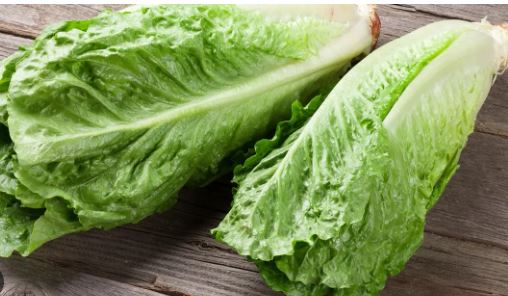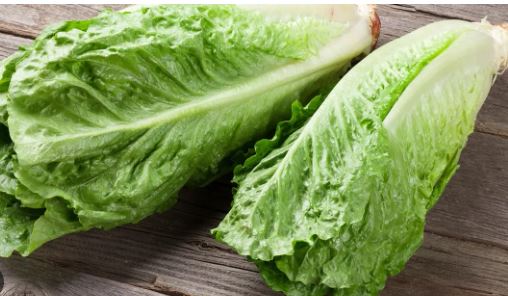
Lettuce is an annual plant of the family Asteraceae. It is most often grown as a leaf vegetable, but sometimes for its stem and seeds. Lettuce is most often used for salads, although it is also seen in other kinds of food, such as soups, sandwiches and wraps; it can also be grilled and sometimes even as a garnish or a base for other dishes. While the exact origins of Asparagus lettuce are unknown, it is thought to have originally come from the Mediterranean coast and was brought to China around the time of the Tang Dynasty 618-907 CE.
The lettuce first appeared in the United States in the 1890s and was sold in seed form under the name Asparagus lettuce with little popularity. It was David Burpee, founder of Burpee Seed Company, who brought the vegetable to fame about fifty years later. After receiving Asparagus lettuce seeds from an American missionary in China, Burpee decided to rename the vegetable Celtuce, a combination of “celery” and “lettuce,” and began selling Celtuce seeds in the United States in 1942. Today Asparagus lettuce can be found in fresh markets in Asia and at specialty grocers and Asian markets in Europe and the United States.
Lettuce grows best in cooler temperatures, which is why it’s often a spring or fall crop. However, with modern agricultural techniques, it’s cultivated year-round in controlled environments like greenhouses. It’s relatively fast-growing, which allows for multiple harvests in a season.
Lettuce has been grown in space! NASA conducted experiments with romaine lettuce on the International Space Station to study plant growth in space, aiming towards sustainable food sources for long-duration space travel.
Lettuce can be used in stir-fries, soups, slow-simmered stews, minced into wontons, or sautéed and tossed with sesame oil. It can also be pickled and is commonly served with rice porridge to create a salty, sweet flavor. The tender leaves at the top of the stems are steamed, stir-fried, or added to soups and pasta.
Lettuce pairs well with chilies, spring onions, garlic, ginger, soy sauce, sesame oil, olive oil, Sichuan peppercorns, lemon, wood ear mushrooms, yams, pork, tofu, poultry, tomatoes, avocado, lotus root, cucumber, and walnuts. They will keep for a couple of days when the leaves are removed from the stem and stored separately in the vegetable crisper drawer of the refrigerator.

Types of Lettuce
Iceberg (Crisphead):
- Origin: USA, developed in the early 20th century.
- Characteristics: Very crisp, pale green, tightly packed leaves, mild flavor, commonly used in salads and sandwiches.
Romaine (Cos):
- Origin: Eastern Mediterranean region.
- Characteristics: Long, sturdy leaves, strong taste compared to iceberg, crunchy texture, used in Caesar salads.
Butterhead (Bibb or Boston):
- Origin: Mediterranean.
- Characteristics: Soft, buttery leaves, mild, sweet flavor. Boston lettuce has larger, looser leaves than Bibb.
Leaf Lettuce (Looseleaf):
- Origin: Ancient Egypt.
- Characteristics: Doesn’t form a head; leaves are loose. Comes in red or green varieties, mild flavor, tender texture.
Arugula (Rocket):
- Origin: Mediterranean region.
- Characteristics: Peppery taste, small, lobed leaves, often used in salads for a spicy kick.
Endive (Belgian Endive):
- Origin: Belgium.
- Characteristics: Bitter flavor, grown in darkness to keep leaves white, crisp texture.
Chicory (Curly Endive):
- Origin: Mediterranean.
- Characteristics: Frilly edges, slightly bitter, used in salads for texture and flavor.
Frisée:
- Origin: Similar to chicory, likely Mediterranean.
- Characteristics: Finely curled, bitter leaves, but milder than chicory.
Escarole:
- Origin: Mediterranean.
- Characteristics: Broad, slightly bitter leaves, used in both raw salads and cooked dishes.
Batavia Lettuce:
- Origin: France or Netherlands.
- Characteristics: Similar to Iceberg but with a more pronounced flavor, leaves are wavy and less dense.
Mâche (Lamb’s Lettuce or Corn Salad):
- Origin: Europe.
- Characteristics: Small, delicate, dark green leaves, nutty flavor, tender.
Radicchio:
- Origin: Italy.
- Characteristics: Red or purple leaves, bitter and spicy taste, often grilled or used in salads for color.
Lollo Rossa:
- Origin: Italy.
- Characteristics: Frilly, red-tipped leaves, mild flavor, used for garnish and salad mix.
Oak Leaf:
- Origin: Mediterranean.
- Characteristics: Shaped like oak leaves, comes in red and green, tender, with a slightly nutty flavor.
Cress (Garden Cress):
- Origin: Persia (modern-day Iran).
- Characteristics: Peppery, tangy flavor, very small leaves.
Watercress:
- Origin: Ancient times, likely Asia or Europe.
- Characteristics: Small, round leaves, peppery taste, often used in soups, salads, and sandwiches.
Tatsoi:
- Origin: Asia.
- Characteristics: Small, spoon-shaped leaves, mild mustard flavor, used in salads or stir-fries.
Mizuna:
- Origin: Japan.
- Characteristics: Jagged leaves, peppery, slightly spicy, often in mesclun mixes.
Miner’s Lettuce (Claytonia):
- Origin: North America.
- Characteristics: Succulent, mild, slightly tangy, grows wild in some areas.
Red Salad Bowl:
- Origin: Cultivated variety.
- Characteristics: Deep burgundy, loose leaves, sweet and tender.
Green Ice:
- Origin: USA.
- Characteristics: Very crisp, similar to Iceberg but with frilled leaves.
Little Gem:
- Origin: UK.
- Characteristics: Small, compact, sweet, with a crisp texture, like a mini romaine.
Purslane:
- Origin: Possibly India or Persia.
- Characteristics: Thick, succulent leaves, slightly lemony taste, can be eaten raw or cooked.
Speckled Lettuce (Forellenschluss):
- Origin: Austria.
- Characteristics: Green with red speckles, butterhead type, sweet flavor.
Deer Tongue (Matchless):
- Origin: North America.
- Characteristics: Pointed, tongue-shaped leaves, nutty flavor, robust texture.
Mesclun Mix:
- Origin: Provence, France.
- Characteristics: Not a single type but a mix, includes various young lettuce leaves and other greens for diversity in flavor (sweet, bitter, spicy).
Spinach (though not technically lettuce, often grouped with salad greens):
- Origin: Central and Southwestern Asia.
- Characteristics: Deep green, tender leaves, rich in iron, can be eaten raw or cooked.
Gem Lettuce:
- Origin: Similar to Little Gem, likely European development.
- Characteristics: Small, crisp, sweet, often used in individual servings.